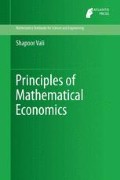Abstract
A sequence is an ordered set of numbers. Consider the sequence of real numbers expressed as
Access this chapter
Tax calculation will be finalised at checkout
Purchases are for personal use only
Notes
- 1.
Actually the notation used to indicate repeating decimal is putting a \(-\), called overline or overbar, over the repeating decimal, like \(3.4\overline{35}\).
- 2.
To be mathematically correct, (12.13) must be expressed as \(P(t) = P e^{it}\) to indicate \(P\) as a function of the continuous variable \(t\) (time). We are ignoring these subtleties.
- 3.
The interest paying bonds are called coupon bonds.
- 4.
The par or face value of a bond is its denomination. Bonds are issued with various denominations, generally with increments of $1,000, like $1,000, $2,000, and so on.
- 5.
Interests are commonly paid semiannually. We ignore this twist here.
- 6.
We are treating the subject of fixed income (bond) valuation rather casually here. In the real world bond valuation is much more complex and involves many different variables and factors. One very important factor is the financial health and creditworthiness of the bond issuing entity. Perception of investors of potential default risk by issuers of bond (or any other financial debt instrument, for that matter) plays a major role in shaping demand for these papers and their prices in the financial market. The financial crisis of 2008 proved, once again, that the investors’ trust and confidence in the financial health of a company trumps all other factors. This manifested itself vividly when bonds issued by faltering corporations like GM and AIG were offered at a fraction of their face values and nobody was buying.
Our exposition of the subject here is elementary, providing a first approximation method for investment evaluation.
- 7.
A basis point is one hundredth of a percentage point, that is 0.01 percentage point is equal to 1 basis point. It is used in the financial industry to denote a rate change or the difference (spread) between two rates.
- 8.
To avoid disrupting the flow of our discussion, the technical detail of estimating \(t\) is deferred to the Appendix.
- 9.
The definition of “jumbo mortgage” changes over time. It is generally a loan amount above the industry standard conventional loan. Currently in some real estate markets loans larger than $417,000 are considered jumbo loans.
- 10.
Again, to avoid disrupting our discussion, the technical details of estimating \(i'\) are presented in the Appendix.
- 11.
Points (a point equals one percent of the amount of the mortgage loan) are fees that the mortgage lender charges for making the loan. Points are prepaid interest, or interest that is due when the loan is taken out. Lenders offer lower rates with the payment of more points.
- 12.
I assume that deposits are made at the beginning of each period. This type of annuity is called Annuity-due.
- 13.
College funds are known as 529 Plans. A 529 plan is a tax-advantaged savings plan designed to encourage saving for future college costs. 529 plans, legally known as “qualified tuition plans,” are sponsored by states, state agencies, or educational institutions and are authorized by Sect. 529 of the Internal Revenue Code (See U.S. Securities and Exchange Commission at www.sec.gov/investor/pubs/intro529.htm).
Author information
Authors and Affiliations
Corresponding author
Appendix A: Estimating Time \(t\) and New Interest Rate \(i'\) for Sect. 12.5
Appendix A: Estimating Time \(t\) and New Interest Rate \(i'\) for Sect. 12.5
In the text we found ourselves faced with solving the following scary exponential equation
Solving this equation is equivalent to finding the zero(s) of the function
The graph of the above function indicates that an acceptable solution for \(t\) is between 210 and 230 (Fig. 12.2).
The Table 12.5 further narrows down the solution for \(t\) between 215 and 220.
Using Taylor linear approximation, we expand the function around \(t=220\).
Now we can write the linear approximation of the function as
The zero of this function is
Next we encountered problem of determining \(i'\) such that the it satisfies
Assuming equality between the left and right hand sides, we simplify the expression to
Taking the logarithm of both sides, we have
and finally,
Solution to this logarithmic function is equivalent of finding zero(s) of the function
Table 12.6 indicates that the solution must be in the neighborhood of \(i' = 0.04\) (Fig. 12.3).
We expand the function around this :
The linear function is
The zero of this function is a linear approximation to \(i'\):
Note that we can use WolframAlpha and solve the for \(i'\) in Eq. (12.32). We enter (by using \(x\) instead of \(i'\))
There are two possible answers. The first one is a negative number that must be discarded. The second answer (to four decimal places) is \(x=0.0417.\) WolframAlpha interpret \(log\) as the natural logarithm. The symbol for \(log\) at base 10 is \(log10.\)
Rights and permissions
Copyright information
© 2014 Atlantis Press and the authors
About this chapter
Cite this chapter
Vali, S. (2014). Mathematics of Interest Rates and Finance. In: Principles of Mathematical Economics. Mathematics Textbooks for Science and Engineering, vol 3. Atlantis Press, Paris. https://doi.org/10.2991/978-94-6239-036-2_12
Download citation
DOI: https://doi.org/10.2991/978-94-6239-036-2_12
Published:
Publisher Name: Atlantis Press, Paris
Print ISBN: 978-94-6239-035-5
Online ISBN: 978-94-6239-036-2
eBook Packages: Mathematics and StatisticsMathematics and Statistics (R0)



